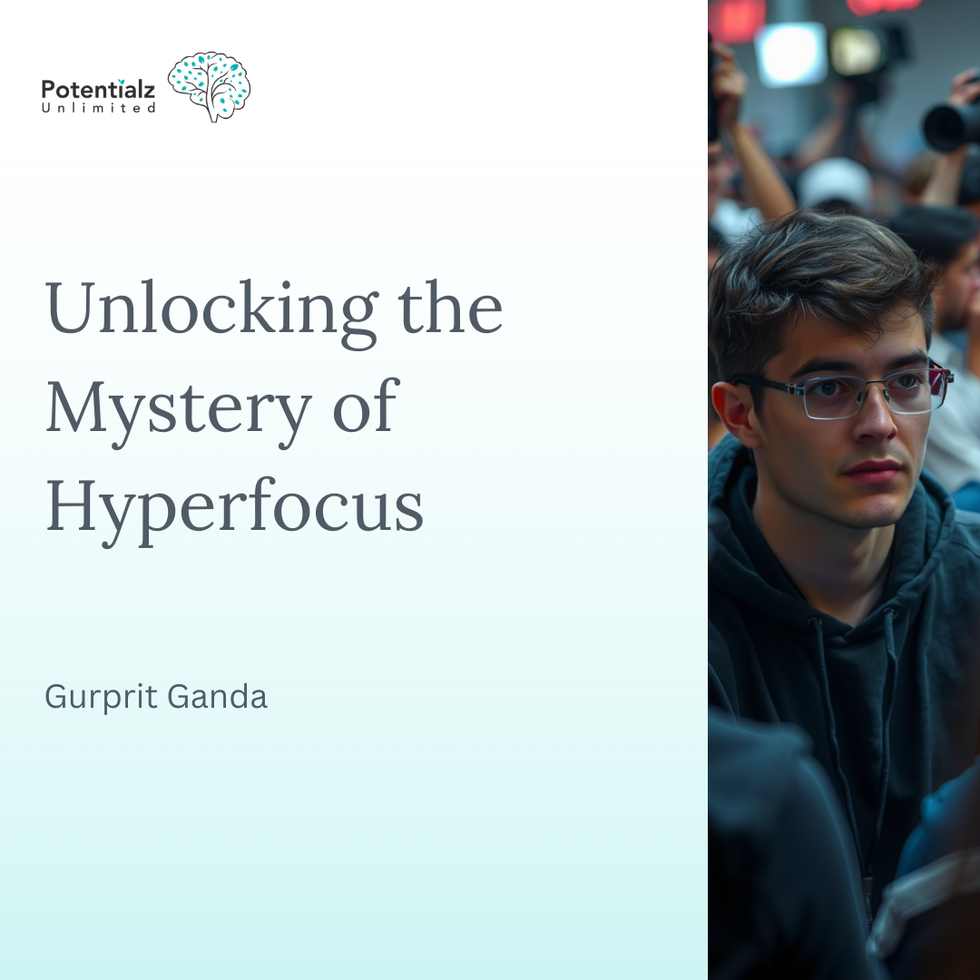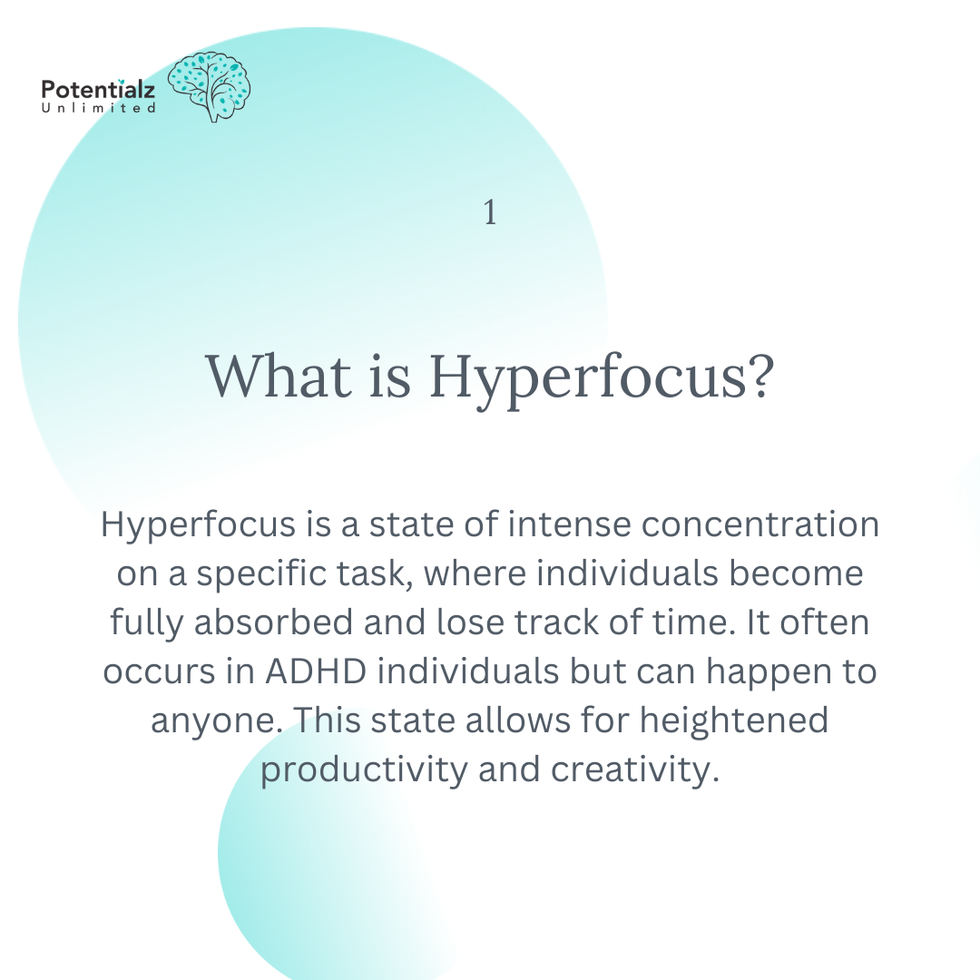ADHD and Hyperfocus: How to Harness It for Productivity
- Gurprit Ganda

- Apr 14
- 6 min read

Have you ever been so absorbed in an activity that hours flew by without you noticing? Where the world around you seemed to disappear, and you were completely immersed in what you were doing? If you have ADHD, you've likely experienced this phenomenon known as hyperfocus—a seemingly contradictory symptom to the distractibility typically associated with ADHD.
Hyperfocus is a fascinating aspect of ADHD that, when properly understood and managed, can become your secret weapon for productivity. Let's explore what hyperfocus is, how it affects people with ADHD, and most importantly, how you can harness this intense concentration to your advantage.
Understanding Hyperfocus in ADHD
Hyperfocus refers to an intense state of concentration where a person becomes completely absorbed in a task or activity for an extended period. During this state, people often appear to ignore everything around them, losing track of time and their surroundings.
While ADHD is commonly associated with difficulty maintaining attention, hyperfocus represents the opposite end of the attention spectrum. Rather than a deficit of attention, ADHD involves challenges with regulating attention. This means that while mundane tasks might be difficult to focus on, activities that are interesting or stimulating can trigger intense concentration.
According to ADHD expert Russell Barkley, Ph.D., "Children and adults with ADHD have difficulty shifting attention from one thing to another. If they're doing something they enjoy or find psychologically rewarding, they'll tend to persist in this behavior after others would normally move on to other things".
The Science Behind Hyperfocus
Like distractibility, hyperfocus is thought to result from abnormally low levels of dopamine in the brain's frontal lobes. This dopamine deficiency makes it challenging to "shift gears" from engaging activities to necessary but less stimulating tasks.
The ADHD brain is naturally drawn to activities that provide immediate feedback and stimulation. When engaged in something interesting, the brain receives the dopamine it craves, creating a reward loop that makes it difficult to disengage.
The Double-Edged Sword of Hyperfocus
Benefits of Hyperfocus
When channeled properly, hyperfocus can be incredibly beneficial:
Increased productivity: When hyperfocused on work-related tasks, you can accomplish an incredible amount in a short time with laser-sharp accuracy.
Enhanced creativity: Deep concentration can fuel creative problem-solving and innovation.
Reduced stress: Completing more tasks efficiently can lead to less stress and a greater sense of accomplishment.
Improved work quality: When fully engaged in a task, you're less likely to make careless mistakes.
Challenges of Hyperfocus
However, hyperfocus can also present challenges:
Time management issues: Losing track of time while hyperfocused can lead to missed appointments or deadlines for other tasks.
Neglected responsibilities: Important tasks may be overlooked in favor of more engaging activities.
Disrupted routines: Basic needs like eating or sleeping might be ignored during periods of intense focus.
Social difficulties: Hyperfocus can sometimes be misinterpreted as ignoring others or being uninterested in social interaction.
Harnessing Hyperfocus for Productivity
The key to making hyperfocus work for you is not fighting against it but learning to direct it toward productive activities. Here are strategies to help you harness your hyperfocus:
1. Create the Optimal Environment
Set yourself up for success by creating conditions that encourage productive hyperfocus:
Gather all necessary tools: Before starting a task, collect everything you'll need to complete it. Creating a checklist can be helpful to ensure you have all materials ready.
Set the mood: Determine what atmosphere helps you focus best. Some people work better with background music, while others prefer silence.
Eliminate distractions: Close unnecessary browser tabs, silence your phone, and turn off notifications that might pull your attention away.
2. Implement Time Management Techniques
Establish systems to help you maintain awareness of time while hyperfocused:
Set timers: Use alarms to break up intense periods of focus. This helps prevent spending too much time on one task at the expense of others.
Schedule breaks: Plan regular intervals to step away from your work. This helps maintain energy and prevents burnout.
Become a clock-watcher: Keep visible clocks nearby and make note of the time when you start tasks.
Allow extra time: Since people with ADHD often underestimate how long tasks will take, add a buffer of extra time to your estimates.
3. Prioritize and Structure Your Tasks
Organize your work to make the most of hyperfocus states:
Identify your peak productivity hours: Observe when you're naturally most focused and schedule important tasks during these times.
Break projects into smaller segments: Dividing large projects into smaller, more manageable parts makes them less overwhelming and more engaging.
Use color-coding and lists: Visual organization systems can help prioritize tasks and keep you on track.
4. Make Boring Tasks More Engaging
Find ways to make necessary but less stimulating tasks more appealing:
Remix your routine: Introduce novelty into repetitive tasks by changing your environment or adding stimulating elements like music or podcasts.
Gamify your work: Turn tasks into challenges with rewards to activate the brain's reward system.
Work in short bursts: Use techniques like the Pomodoro method (25 minutes of work followed by a 5-minute break) to maintain focus on less engaging tasks.
5. Develop Self-Awareness
Understanding your patterns of hyperfocus is crucial for managing it effectively:
Identify warning signs: Learn to recognize when hyperfocus is taking a toll on your well-being, such as skipping meals or losing sleep.
Schedule tasks at your own pace: Don't pressure yourself to work at the same speed as others. Find a rhythm that works for you.
Create reminders: Set alarms for essential activities like eating, taking medication, or attending appointments.
A 7-Step Formula for Productive Hyperfocus
ADDitude Magazine suggests this practical approach to training your brain for productive hyperfocus:
Gather all necessary tools before beginning your project.
Set the mood by creating optimal working conditions for your brain.
Turn off all distractions, including social media, email notifications, and your phone.
Decide on a time frame for focused work (typically 30-45 minutes works well).
Set an alarm clock to signal when your focused time is up.
Take a break when the alarm sounds—drink water, stretch, or walk around.
Repeat the process until it becomes second nature.
Real-Life Applications of Productive Hyperfocus
In the Workplace
Hyperfocus can be particularly valuable in professional settings:
Complex problem-solving: Channel hyperfocus toward challenging projects that require deep thinking.
Creative work: Use intense concentration for creative tasks like design, writing, or innovation.
Learning new skills: Apply hyperfocus to mastering new technologies or professional development.
In Education
Students with ADHD can benefit from directed hyperfocus:
Study sessions: Create distraction-free environments for studying important material.
Research projects: Use hyperfocus to dive deep into research topics.
Exam preparation: Channel intense concentration toward understanding complex concepts.
When to Seek Support
While self-management strategies are helpful, sometimes professional support is necessary. Consider seeking help if:
Hyperfocus consistently interferes with essential daily activities
You struggle to direct your attention toward necessary tasks
Self-management strategies aren't providing sufficient improvement
Treatment options might include:
Medication: Can help regulate attention and reduce symptoms.
Cognitive-behavioral therapy: Provides strategies for managing ADHD symptoms.
ADHD coaching: Offers personalized support for developing effective routines and habits.
Embracing Your ADHD Brain
Rather than viewing ADHD as solely a deficit, consider it an "attention abundance disorder," as described by Frank Coppola: "Everything is just so interesting, remarkably at the same time". This perspective shift can help you appreciate the unique strengths of your ADHD brain.
By understanding hyperfocus and implementing strategies to direct it productively, you can transform what might seem like a limitation into a powerful tool for achievement. The key is creating structures that work with your brain rather than against it.
Remember that managing hyperfocus is a skill that develops over time. Be patient with yourself as you learn what works best for you. With practice and persistence, you can harness your hyperfocus to become more productive, creative, and fulfilled in both your personal and professional life.
Final Thoughts
Hyperfocus isn't unique to people with ADHD—everyone experiences it to some degree. However, for those with ADHD, it can be more frequent and intense. By understanding this aspect of your neurology and developing strategies to work with it rather than against it, you can transform hyperfocus from a potential obstacle into your secret productivity superpower.
The journey to mastering hyperfocus may have challenges, but the rewards—increased productivity, enhanced creativity, and greater life satisfaction—make it well worth the effort. Start small, be consistent, and watch as you gradually gain more control over your attention and accomplish things you never thought possible.
References:
Groen, Y., Priegnitz, U., Fuermaier, A. B. M., Tucha, L., Tucha, O., Aschenbrenner, S., Weisbrod, M., & Garcia Pimenta, M. (2020). Testing the relation between ADHD and hyperfocus experiences. Research in developmental disabilities, 107, 103789. https://doi.org/10.1016/j.ridd.2020.103789
Barkley, R. A. (2013). Taking Charge of Adult ADHD (3rd ed.). The Guilford Press.
Dodson, W. (2023). ADHD and Motivation: 10 Productivity Hacks for Adults with ADHD. ADDitude Magazine. Retrieved from https://www.additudemag.com/understanding-adhd-hyperfocus/
Emeritus. (2024). How to Hyperfocus at Work to Increase Productivity. Emeritus Blog. Retrieved from https://emeritus.org/blog/hyperfocus-best-skills-to-have/
Healthline. (2025). What Is Hyperfocus and How Does It Affect People with ADHD? Healthline. Retrieved from https://www.healthline.com/health/adhd/adhd-symptoms-hyperfocus
The Mini ADHD Coach. (2023). Managing ADHD Hyperfocus and Turning Them to Our Advantage. Retrieved from https://www.theminiadhdcoach.com/living-with-adhd/adhd-hyperfocus
ADD.org. (2024). ADHD Hyperfocus: The Secret Weapon to Unleashing Productivity. Retrieved from https://add.org/adhd-hyperfocus/
BetterHelp. (2024). How To Harness ADHD Hyperfocus To Increase Productivity. Retrieved from https://www.betterhelp.com/advice/adhd/use-your-adhd-hyperfocus-to-be-productive/
ADDitude Magazine. (2023). Hyperfocus — at Your Service: 7 steps to help your ADHD brain harness that amazing ability to concentrate. Retrieved from https://www.additudemag.com/hyperfocus-at-your-service/
Cleveland Clinic. (2025). Understanding Hyperfocus and ADHD. Cleveland Clinic Health Essentials. Retrieved from https://health.clevelandclinic.org/hyperfocus-and-adhd
Medical News Today. (2024). ADHD and hyperfocus: What is it, and how can I manage it? Retrieved from https://www.medicalnewstoday.com/articles/325681
HelpGuide.org. (2025). Tips for Managing Adult ADHD. Retrieved from https://www.helpguide.org/mental-health/adhd/managing-adult-adhd














Comments